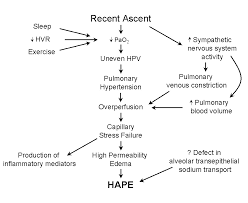High altitude Pulmonary Edema (HAPE) and High Altitude Cerebral Edema are two different forms of Acute Mountain Sickness (AMS). As per studies AMS affects about 40 percent travellers at an altitude of up to 10,000 feet and more than 50 percent on routes on higher altitudes which are mostly taken by trekkers.
High altitude pulmonary edema affects the lungs whereas High altitude Cerebral Edema affects the brain of the person. In HAPE an extra vascular fluid which is a fluid outside the blood vessels accumulates in the lungs of a person at high altitudes. This mostly happens when the person climbs the height very fast and this trek involves vigorous exercise. This leads to shortage of breath or dyspnoea as it is called, cough, fast heart rate and decreased oxygen levels in the arteries. On the other hand, High altitude cerebral edema is a form of AMS where the brain swells and ceases to function in the usual manner. This increases intracranial pressure and can lead to death. The major symptoms are
vomiting and nausea, lethargy, confusion, loss of balance, seizure and this all can finally result in coma.
HACE is said to occur after the trekker ascends the altitude very fast whereas HAPE is usually said to occur on the second day after the person has ascended. HACE generally affects the people who continue to ascend with the symptoms of acute mountain sickness whereas HAPE affects young and healthy trekker.
One major difference between HAPE and HACE is that HACE always is accompanied by the usual symptoms of AMS whereas HAPE it not related to the signs of AMS. The main symptoms of AMS are Loss of appetite, fatigue, weakness, dizziness etc.
HAPE can be treated by immediately starting to descend and go down 2000 feet to 4000 feet and this should be tried and done when the victim has the power to do it himself. It should also be tried that the victims are kept warm and oxygen should also be given if it available. For a victim of HACE, decent also should be started immediately irrespective of the time of the day and the victim should be brought down to the level where he felt well and was awake.
HACE can be prevented as it starts with the symptoms of AMS and if one continues to climb the altitude with the symptoms he is more susceptible to be a victim of the cerebral problem. On the other hand HAPE need not be accompanied by the usual AMS symptoms and thus, can at times be not avoided. As per studies a person affected by HACE may not be affected by HAPE but a person affected by HAPE can also develop HACE because of low levels of oxygen in the blood.
HAPE and HACE are too severe forms of acute mountain sickness which happens when people ascend to very high altitudes for example, Mount Everest. One affects the lungs whereas the other affects the brain.

0 comments:
Post a Comment